
Day 6: Earth, Wind and Oil
March 25, 2021
Day 4: Atoms, Arts and Aliens
March 23, 2021Most recently updated on March 5, 2024
Driven on March 25, 2022
Originally posted on March 24, 2021
Today, it’s all about the border.
We start our Day 5 route by backtracking a bit, heading west on Interstate 10. After an hour, we turn left and travel south on the lonely two lanes of Highway 11.
A half-hour later as we edge near Mexico, we come across the town of Columbus.
This community of 1,500 people actually used to sit right at the border when it was established in 1891. However, in 1902 the village was moved three miles north when the El Paso and Southwestern Railroad built a depot.
The trains originally transported copper ore as well as livestock and mail to El Paso, Texas. It had minimal traffic in the 1920s and 1930s. After being put to some use during World War Two, the depot faded and was closed in 1961.
In 1916, Columbus did receive some notoriety that lives on today.
It was here that Mexican folk hero Pancho Villa led his soldiers across the border and attacked the U.S. Calvary Regiment at their living quarters. Villa organized the assault because his 500-person squadron needed food, water and horses.

Pancho Villa State Park in Columbus, New Mexico, is at the site of the only ground invasion of the United States since the War of 1812. Photo by the Deming Headlight.
His unit killed seven of the U.S. regiment’s 350 soldiers as well as eight Columbus residents. However, Villa’s squadron suffered 190 casualties and was forced to flee back into Mexico.
The battle remains the only ground invasion of the United States since the War of 1812.
The U.S. government did not take kindly to Villa’s bold maneuver.
The military sent 10,000 troops under Gen. John Pershing into Mexico to pursue Villa. It was the first U.S. military expedition to use automobiles and airplanes.
After 11 months, Pershing’s forces gave up the search for Villa after killing some of his associates.
The attack is commemorated at Pancho Villa State Park in the center of town. The park contains the original buildings of Camp Furlough as well as some camping and RV facilities. There are those in town who feel the park shouldn’t be named after the Mexican revolutionary, but others feel it’s Villa’s name that brings in tourists.
When we paid a visit in March 2022, a charter bus full of military personnel pulled in right after us. They were members of the Sergeants Major Academy from Fort Bliss in El Paso, Texas. The institution provides a 10-month leadership training program for people who’ve been in the military at least 17 years.
Jan Hecht, an academy international instructor at the academy, told 60 Days USA about 60 academy cadets are from foreign countries and other 600 are U.S. Army personnel.

A display at the Pancho Villa State Park museum in Columbus, New Mexico
Hecht, who is from Germany, said they use the Pancho Villa site to teach the military students some battlefield lessons. Among them are how the U.S. encampment should have had some lookouts on top of a hill near their facilities when Villa attacked. They also examine Villa’s high risk incursion for what appeared to be low yield gains as well as the fact Villa seemed to be unaware the U.S. solders were equipped with machine guns.
Hecht said in the recent past the training has been useful for soldiers in Afghanistan and Iraq.
Nancy Terpstra, a volunteer inside the museum, said the facility gets between 100 and 200 visitors a week. Most are history buffs or people who have heard Pancho Villa’s name but aren’t sure what his connection is to U.S. history.
She said the museum informs people about the raid but also what U.S. military personnel learned about warfare using planes and vehicles before entering World War One the following year.
In 2011, Columbus received another bit of notoriety.
That’s when the city’s police force was dissolved after a gun smuggling scandal in which 14 people were charged and 12 ended up pleading guilty. Among those accused were the mayor, a former police chief and a village trustee.
An 84-count indictment stated that the defendants organized an operation that smuggled more than 200 weapons into Mexico in a deal with the Juarez drug cartel.
The police department now consists of three officers overseen by the Luna County Sheriff’s Department.
Columbus has always been closely linked to Mexico.
Many of the workers are people who legally cross the border three miles to the south every workday to come to their jobs.
The community’s proximity to the border lured a small group of self-described militia members to roll into town on the day before the midterm elections in November 2018. The militiamen said they were there to stop a “caravan” of illegal immigrants headed to the region. Columbus Mayor Esequiel Salas politely told the militia members they weren’t needed as his town and their sister village of Palomas on the other side of the border get along just fine.
A few weeks later, Salas rejected the federal government’s proposal to send troops to the area. Instead, he said, the town could use better roads to attract more tourists.
Columbus’ economy has struggled for a while now. The town’s median household income is less than $25,000 a year.
Columbus Elementary School in the northwest corner of town is also part of the border culture.
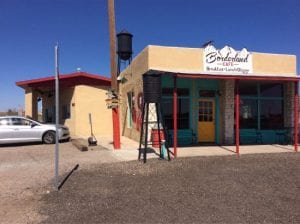
The Borderland Cafe in Columbus, New Mexico. Photo from Tripadvisor.
Many of the school’s 480 students are children who travel from Mexico with their parents to attend school while their mothers and fathers work.
About 90 percent of the school’s pupils come from homes where Spanish is the primary language. People who work at Columbus Elementary are required to be bilingual.
The students score above the state average in math proficiency in reading skills. Overall, Columbus Elementary is in the top 30 percent of schools in New Mexico.
In midst of all this is the Borderland Café, which sits downtown two blocks from Pancho Villa State Park. Adriana Zizumbo and Lawrence Haddad opened the small, colorful restaurant in 2017 as a way to bring fresh, nutritious food to Zizumbo’s hometown.
———————————-
We leave the Borderland Café and immediately get on Highway 9, heading east on the two-lane road that skirts the Mexican border for the next 70 miles.
It was along this stretch of highway that crews began building a 30-foot-high steel border fence in August 2019. The construction was funded with money from a national emergency declaration issued by President Donald Trump.
By January 2020, six miles of this barrier between Columbus and the Texas border had gone up despite objections from environmentalists and some immigration activists.
In April 2020, a group of Columbus residents penned a letter to the governor, objecting to the mobile homes that housed the wall’s construction crews. Their main concern was that out-of-state workers could bring COVID-19 to their town.
A border wall paid for by Mexico was a signature campaign promise of Trump when he successfully ran for president in 2016.
When President Trump arrived at the White House, 654 miles of the United States’ 1,933-mile border with Mexico had a primary barrier. In July 2020, there were 657 miles, an increase of three miles. In December 2020, the group factcheck.org estimated that 40 miles of new fencing had gone up during the Trump administration.
The group noted that much of the 365 miles of the 438 miles of border wall construction touted by the White House was actually replacing existing barriers built in previous administration, albeit with stronger and more secure structures.
Mexico, by the way, didn’t hand over one cent of the $15 billion cost.
It wasn’t just money and logistics that hampered the project. It was also reluctance of property owners.
Residents in the southern tip of Texas between Laredo and Brownsville are among the folks who refused to sign over their land to build new sections of the border fence.
If you want to get a visual status report, USA Today has built an interactive map that takes you on a guided tour of the fencing from the Gulf of Mexico to the Pacific Ocean.
The virtual tour shows the large gaps in the fencing along the 1,200 miles of border between Texas and Mexico as well as the plentitude of security barriers in some of the flat desert areas of California, Arizona and New Mexico.
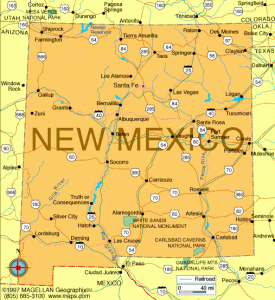
You can see some of these steel barricades as you approach the Texas border. Just before you get there, you come across the city of Sunland Park.
The New Mexico community of 18,000 is across the Rio Grande from El Paso, Texas. It also nudges up against the Mexico border. The population is listed as 94 percent Hispanic or Latino with an annual median household income of $45,000 and a poverty rate of 24 percent.
It’s home to the Sunland Park Racetrack and Casino, a family-owned facility that in summer 2020 donated $2 million to help New Mexico residents affected by COVID-19.
The town is also the place where in 2019 a private group called We Build the Wall erected a half-mile of border fencing on private property after some legal jousting with the city over permits.
We Build the Wall reported it raised $25 million through online donations from private donors to construct a total of 100 miles of border barriers.
The organization came under fire in August 2020 when four of its leaders, including former White House advisor Steve Bannon, were arrested and charged in a federal indictment by the U.S. Attorney’s Southern District of New York office with using some of that donated money for private expenses. Bannon was scheduled to go on trial on May 2020, but he was pardoned by President Trump in the final days of that administration. In September 2022, prosecutors in New York filed state charges against Bannon over the fundraising efforts for “We Build the Wall.” He has pleaded not guilty. A trial date has been set for May 2024.
In May 2021, the organization’s co-founder, Brian Kolfage, was indicted by federal prosecutors on tax fraud charges. In the indictment, authorities said Kolfage failed to report $350,000 he received from We Build the Wall donations on his 2019 tax returns. The court documents state that Bannon received $1 million. In July 2021, Kolfage was also indicted in Florida on tax-related charges. In April 2022, Kolfage pleaded guilty to defrauding investors under a plea agreement with prosecutors. He agreed to forfeit money donated to his organization. In April 2023, Kolfage was sentenced to 51 months in federal prison.
The privately built wall wasn’t Sunland Park’s only brush with border controversy.
In April 2019, a member of a self-proclaimed militia was arrested in Sunland Park on charges of firearms possession by a felon. Authorities say members of the United Constitutional Patriots had detained as many as 300 migrants at gunpoint along the Mexico border while they called the Border Patrol.
A few days later, the United Constitutional Patriots members were told by police to leave the camp they had set up in Sunland Park.
In January 2020, Larry Mitchell Hopkins pleaded guilty to the firearms charge. In April 2020, he was sentenced to 21 months in prison.
Border Towns
From Sunland Park we cross the Rio Grande and say goodbye to New Mexico and hello to Texas.
We follow the local expressways to Interstate 10 and zoom past El Paso. We end our route there today, but there are some places along the border we need to visit first.
In 2021, the border crisis mostly happened about 8 hours southeast of this part of Texas in places such as Carrizo Springs. Among the issues, the Biden administration spent much of March 2021 trying to find facilities to house more than 14,000 unaccompanied children who have arrived at the U.S. border. The children were part of the flow migrants from Mexico and Central America that have steadily streamed to the border the previous two months.
The towns we will visit today dealt with immigration issues during the four years of the Trump administration as well as facing some new immigration challenges today.
The first is Fort Hancock, a community about an hour southeast of El Paso along Interstate 10.
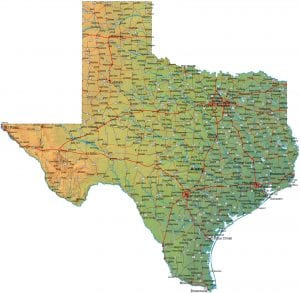
This town of 1,200 people straddles the Rio Grande as well as the Mexico border. Its median annual household income is $30,000.
The community was established in 1881 as Fort Rice along the old San Antonio-El Paso Road to defend against tribal attacks and renegade bandits. It was renamed Fort Hancock in 1886 after Gen. Winfield Scott Hancock, a hero of the Battle of Gettysburg during the Civil War.
The fort was abandoned in 1895. A marker in a cotton field west of town is all that’s left.
Despite that closure, the town was starting to grow by the late 1800s. A railroad depot had opened in 1887. In 1890, Fort Hancock had 200 residents with a general store, post office, hotel and meat market.
The population fluctuated during the 20th century from 400 in the 1920s to less than 200 in the 1930s to 500 in the 1940s to 300 in 1970s before slowing rising to 1,700 by 2000.
In the 1930s and 1940s, Fort Hancock was an active cotton producing center. It was also known for its piquant chili peppers.
For decades, there was a friendly relationship between Fort Hancock residents and the Mexican citizens living just across the Rio Grande.
Much of the border was protected by simple barbed wire fencing. In fact, it’s in Fort Hancock where Morgan Freeman’s character Ellis Boyd “Red” Redding in “The Shawshank Redemption” crosses into Mexico to find Tim Robbins’ character Andy Dufresne.
That friendly atmosphere suddenly changed in 2010 when Fort Hancock residents became worried about the violence in Mexico connected to drug cartels. Schools hired security guards and farmers were told to arm themselves.
A portion of new segmented wall was built, but the 18-foot-high barrier abruptly ends at a barbed wire fence. A Fox News story in 2013 detailed how migrants found weak spots in the barrier and crossed. Some died in the hot Texas sun. Others ended up sheltering in barns and even porches of local residents.
Today, Farm Road 1088 still crosses into Mexico over the 1,855-foot Fort Hancock-El Porvenier Bridge. The U.S. Border Patrol has a Port of Entry office there that is responsible for monitoring 40 miles of international border.
The illegal crossings are still occurring.
In January 2021, authorities charged five men with crossing the border near Fort Hancock. They were accused of smuggling drugs in trucks that also contained 77 undocumented migrants.
In March 2021, Border Patrol officials reported there was a 500 percent increase in migrant smuggling in the Fort Hancock region in the first quarter of 2021 compared to the same period a year ago.
In July 2021, law enforcement authorities in Juarez, Mexico, said they are stepping up patrols along this portion of the border due to an increase in illegal smuggling.
In March 2022, a Cuban rancher was sentenced to 38 years in prison for smuggling drugs, illegal immigrants and drug cartel members through his Fort Hancock property.
—————————————–
We double back toward El Paso by traveling west on the rural two lanes of Highway 20.
In less than a half-hour, we arrive in Tornillo, a town built on cotton and pecans.
The community was established in 1909 by a group of El Paso businessmen who formed the Tornillo Townsite Company. It was named after the tornillo tree, a heartwood used to make furniture and paper.
The entrepreneurs laid out the town to take advantage of the dams being built on the Rio Grande for the purpose of turning the region into farmland.
The first big crop of cotton was planted in 1918. Tornillo quickly grew into the largest cotton center in Texas, processing 90 percent of that crop in the El Paso Valley. Cotton remains an important commodity to this day.
The farmers in the area also started growing pecans in 1970. The nuts are now a close second to cotton in Tornillo’s economy.
A pecan orchard, in fact, is the site of a new type of business here.

One of the recording studios at Sonic Ranch in Tornillo,, Texas.
Sonic Ranch sits on 2,300 acres of Tony Rancich’s hacienda on the south side of town. It’s been described as the world’s largest residential recording complex.
Sonic has five main studios, a large tracking room and six other recording rooms. To accommodate visiting musicians, the hacienda has 12 bedrooms, a dining room, a workout room, a barbeque area and a pool. There are four other houses on the site with a total of 15 bedrooms.
Third Eye Blind and Portugal the Man are among the groups that have recorded here.
Like Fort Hancock, Tornillo has its own bridge crossing the Rio Grande into Mexico. The Tornillo-Guadalupe Bridge was dedicated in 2016. It’s 650 feet long with six lanes for traffic and two crossings for pedestrians. It replaced another bridge that was built in 1938.
However, less than a year after it opened, the much-heralded $130 million bridge ran into problems. The amount of commercial traffic was minimal, so much so that one lane was closed and customs inspectors were transferred to other bridges.
Part of the reason for the meager traffic was violence from drug cartels had decimated Mexican towns just across the border. Another reason was Mexico had not finished building a 20-mile connector road from the highway to the new bridge when the span opened.
Bridge traffic is expected to pick up in 2024 as cars and trucks begin using the Tornillo span as other nearby international bridges have repair work done.
Another border controversy gripped Tornillo in recent years.
The first Immigration and Customs Enforcement (ICE) camp for immigrant children opened in Tornillo in June 2018. It quickly became a lightning rod over the debate of children being separated from their parents after families illegally crossed the Mexico border into the United States.
At one point, the camp housed 2,800 teenagers, some of them for as long as 50 days. The camp was the site of a celebrity-filled protest that summer. Rob Reiner, Lena Dunham and Constance Wu were among the entertainers who joined politicians in demonstrating against the Trump administration’s policy of separating migrant children from their parents.
The camp did not last long. After heavy criticism, it closed in January 2019.
If you stop for lunch in Tornillo, a popular place is Mi Cabanita. The small eatery sits downtown along Highway 20, which is known as Alameda Avenue in this town of 1,500 people that’s listed as 99 percent Hispanic with a median annual household income of $49,000.
Another 15 miles west up Highway 20 is the town of Clint. It has a history similar to Tornillo, just with different crops and a familiar kind of border controversy.
Clint developed into an agricultural center in the late 1800s with nine fruit growers and four alfalfa growers by 1896. By 1914, a tomato cannery had opened.
The community of 1,200 people is still a primarily agricultural town, but it also received the national spotlight in June 2019 for an overcrowded border station filled with children and young adults.
Attorneys who had visited the detainees reported that the facility was unclean and unsanitary. They said there were 7-year-olds caring for infants and adults as well as children who hadn’t showered in a week.
Border Patrol agents said the heavy influx of migrants had simply overwhelmed their complex.
Less than two weeks after the story broke, Homeland Security officials removed 300 children from the Clint facility and transferred them to another larger detention camp.
The El Paso Way of Life
We work our way back to Interstate 10 for the quick 30-minute ride to El Paso.
Before we hit downtown, however, we turn north on Highway 375. That road takes us to our first stop in El Paso.
The U.S. Border Patrol Museum contains a variety of exhibits that look back on the 97-year history of the agency.
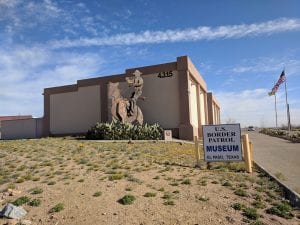
The Border Patrol Museum in El Paso, Texas.
There are two displays of weapons. One is for the guns carried by Border Patrol agents. The other is weapons seized from people arrested.
There are also exhibits on the agency’s uniforms throughout the decades as well as checkpoint and tracking operations. In addition, there are memorials to the more than 120 agents who have died in the line of duty.
The Border Patrol was formed in 1924 by the federal government to protect the country’s ports of entry. Initially, there were 450 patrol inspectors who had to supply their own horse, saddle and uniforms. They were paid $1,680 per year.
In 1925, the patrol agents’ jurisdiction was expanded to the coasts and they were given the power to arrest individuals.
During these early years, liquor smuggling during Prohibition became the main focus. It was the most violent era for the agency as more than 30 officers were killed during this time period.
In 1934, a training school for agents was established in El Paso.
The advent of World War Two heightened the need for the Border Patrol. The number of agents was doubled to 1,531. The agency had difficulty filling all those slots even with war veterans applying for jobs. The agents’ authority was expanded during this time to include patrolling the shores looking for enemy submarines as well as transporting Japanese-American citizens to internment camps.
In the 1950s, the patrol’s emphasis shifted back to illegal immigrants crossing the southern border. In 1954, the agency began a program that was actually called Operation Wetback, named after a derisive term to describe migrants who swam across the Rio Grande to reach the United States. In that initial year, more than 1 million Mexican nationals were arrested. Most of them were field workers.
In the 1960s, a number of hijackings led to Border Patrol agents being deputized as air marshals to fly on commercial plane flights. Some agents also assisted law enforcement during Civil Rights actions. More than 300 Border Patrol inspectors helped the U.S. Marshals agency escort James Meredith as he broke the color barrier by registering at the University of Mississippi in 1962. During protests against Meredith’s admission, 72 Border Patrol agents were injured.

One of the displays at the U.S. Border Patrol Museum in El Paso, Texas
In the 1975, the first female Border Patrol agent was hired and efforts were made to increase minority hiring.
In the 1980s, an increase in illegal immigration as well as drug trafficking prompted the Border Patrol to increase its force to 2,725 agents. The situation was further complicated in April 1980 when Cuban President Fidel Castro announced that any Cubans who wanted to emigrate to the United States could board boats at the harbor and head over. On the first day, 125,000 Cuban refugees made the voyage. The Border Patrol responded by sending an additional 100 officers to Florida. Arrests of illegal immigrants jumped from 760,000 in 1980 to a high of 1.6 million in 1986.
After the 2001 terrorist attacks, the Border Patrol was merged into the Customs and Border Protection agency under the federal office of Homeland Security.
Today, the Customs and Border Protection agency has more than 60,000 employees. It’s one of the world’s largest law enforcement organizations. Its duties range from stopping illegal immigration to protecting against terrorist attacks to assisting with international trade and travel.
More than 18,000 of those CBP workers are assigned to patrol the southern border with Mexico. That’s three times the number from 1996.
The Border Patrol certainly has had its critics over the years. They’ve been accused of everything from corruption to assault to kidnapping. The harshest critics call the agency a “cult of brutality” that acts with nearly complete impunity in the shadows of the desert.
During the height of the illegal migrant crackdown in 2019, there were reports of low morale among Border Patrol agents who felt the public simply hated them.
On the other side, the Border Patrol has its ardent supporters and you’ll find many of them when you visit the agency’s museum here.
C. J. Whitmore, whose father was a Border Patrol agent for 28 years, works at the museum’s front desk. He told 60 Days USA in March 2022 that it’s important for the public to understand the broad duties the agency has. For example, he said visitors are often surprised to see a snowmobile in one of the museum’s exhibits until he informs them that the Border Patrol also keeps watch on the Canadian border.
“A lot of people are surprised at the scope of the agency,” Whitmore said.
He also reminds people of the dangers Border Patrol agents face. A number have died from violent attacks, but others have perished in vehicle crashes or from heat exposure in the desert. About a dozen agents have died from exposure to COVID-19.
“I think people who come here can get a fuller picture of the agency,” Whitmore said.
—————————————–
We head south from the museum toward downtown El Paso.
Before we get there, we take a detour to the eastern portion of the city.
Here we find a Walmart Supercenter next to the Cielo Vista Mall.
The store looks like any large Walmart you’d see anywhere in country. However, on August 3, 2019, this Walmart was the scene of a bloodbath.
On that day, authorities say a young white man walked into the store and started shooting. He killed 22 people before he was arrested. Another 26 people were injured.
The suspect, 21-year-old Patrick Crusius, was indicted on 90 federal charges.
Authorities say Crusius told investigators he drove 650 miles from his hometown of Allen, Texas, to El Paso with the intention of killing as many Mexican citizens as he could. Authorities said they discovered material on an obscure website written by Crusius in which he talked about his hatred of immigrants and Mexicans.
In February 2023 Crusius pleaded guilty to 90 federal charges as part of a plea agreement. In July 2023, he was sentenced to 90 consecutive life sentences.
——————————————–
From the mall, we head west on Interstate 10, reaching the Chamizal National Memorial on the outskirts of downtown.
The memorial commemorates the 1963 treaty that peacefully settled a 100-year border dispute between Mexico and the United States.
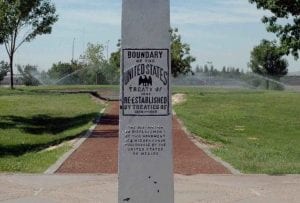
The Chamizal National Memorial park in El Paso, Texas, commemorates a 1963 border agreement between the United States and Mexico. Photo by Destination El Paso.
The dispute began in the 1850s when a flood altered the course of the Rio Grande. The Chamizal tract that was once in Mexico was suddenly on the other side of the river and, therefore, technically on U.S. soil.
In the 1860s, residents of El Paso began to settle onto this 600-acre section of land known as El Chamizal.
In the 1880s, the United States and Mexico agreed on when their international boundary should shift with changes in the Rio Grande’s course and when it shouldn’t.
The two sides, however, could not agree on which country El Chamizal resided in. A 1911 arbitration awarded the land to Mexico, but the United States contested that decision for the next half-century.
The disagreement was finally resolved with the 1963 treaty. In order to trade land with Mexico to implement the agreement, the U.S. government purchased private residential and commercial property. The exchange required 5,600 U.S. residents to move.
The memorial commemorates the history of the dispute as well as the sacrifice made by the people who relocated.
The 55-acre site also hosts cultural performances in a 500-seat theater to showcase the traditions of both countries. It’s also meant to be a symbol of good will between the United States and Mexico.

Pedestrians headed home to Mexico walk along a border bridge between El Paso, Texas, and Cuidad Juarez in March 2022.
J. R. Lujan, a park ranger at the site, told 60 Days USA in March 2022 that the memorial is a tribute to the power of negotiation.
“It’s a small story, but it’s an important story about a peaceful resolution,” Lujan said. “It’s sometimes important to celebrate what didn’t happen.”
The cooperation between the two countries can be seen on the highway bridge that skirts the eastern edge of the memorial just beyond a chain link fence.
Cars line up on both directions of the roadway, some returning to Mexico and others coming back into the United States.
High school students in dress uniforms can also been seen walking along the pedestrian edge of the span. Several hundred of them attend classes at nearby Bowie High School on a daily basis under an international agreement. One female student told 60 Days USA it’s about a 30-minute walk between the school and her home in Cuidad Juarez.
————————————————
We leave Chamizal and finally head into downtown.
El Paso is a multi-faceted community.
It was inhabited by Native Americans for centuries before the first Spanish explorers visited around 1540. Spain ruled over the region from the early 1600s to the early 1800s.
El Paso became part of Mexico in 1821 and then part of the United States in 1848 after the end of the Mexican-American War when the Rio Grande was designated as the international boundary.
Settlements started to rise in the 1850s. The arrival of four railroads in the 1880s turned El Paso into a western boomtown complete with saloons, gambling and gun fights.
In the 1900s, El Paso morphed into an industrial center with smelting operations connected to Mexican mines. The Rio Grande also provided water for cotton and other crops. Oil refineries were eventually built, too.
The city also has a strong military presence.
Fort Bliss was established in 1848. Today, the 1.1 million acre facility is home to 38,000 active duty personnel and their 39,000 family members as well as 13,000 civilian and 1,000 reservists.
Call centers are also a major employer with more than 10,000 people working at them here.
The city is also home to the University of Texas El Paso (UTEP) and hosts the annual Sun Bowl football game.
It’s nicknamed “Sun City” because it gets an average of 302 sunny days a year.
All that sunshine with only 10 inches of rain annually does put pressure on the water supply. So, El Paso is working on a program that would make it the first large city in the United States to treat sewage water to be reused as drinking water. The city already has the world’s largest inland desalination plant, which converts brackish groundwater into potable liquid.
El Paso is the only Texas city on Mountain Time. That allows it to be in sync with Las Cruces, New Mexico, as well as Cuidad Juarez just across the border.
El Paso’s population of nearly 680,000 makes it the sixth most populous city in Texas.
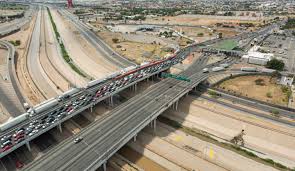
The Bridge of the Americas in El Paso, Texas.
Primarily, though, El Paso is known as a border town.
About 83 percent of its residents are listed as Hispanic or Latino.
There are four international bridges that cross between El Paso and Cuidad Juarez. They are part of the 39 land crossings along the U.S.-Mexico border that bring $1.4 billion in two-way trade per day.
In 2018, El Paso recorded 12 million vehicle trips across its border. That included 80,000 trucks, 16,000 buses and 1,400 trains. In addition, there were 7 million pedestrian crossings.
By comparison, the busiest crossing on the Canadian border is the one in Buffalo, New York, where nearly 5 million vehicles and 360,000 pedestrians come through every year, less than half of El Paso’s traffic.
The border is a way of life in El Paso as people regularly come across the bridges to go to jobs as well as to transport products. The region is the second busiest international crossing point in the country, behind only the San Ysidro checkpoint in San Diego.
The El Paso-Cuidad Juarez metropolitan area contains 2.7 million people, making it the largest bilingual, binational work force in the Western Hemisphere.
The flow across the border usually works well, but there is still an issue with people illegally crossing the border.
City officials report there has been a “migrant crisis” ongoing since 2018. In May 2023, officials reported an influx of migrants as the United States prepared to lift restrictions implemented during the COVID-19 pandemic. In September 2023, local officials said the city was at a “breaking point” as an average of 1,000 migrants per day were coming in.
The city’s new residents will certainly find an international flavor amid the neighborhoods in the southern part of town.
Mata’s Fruit Store, for example, sits just two blocks from the Rio Grande and is within shouting distance of two of the four bridges that join El Paso and Cuidad Juarez.
The store began as a fruit stand owned by the Mata family in 1955 before becoming a grocery in the early 1960s. Today, it’s a busy store with a full service meat market employing 12 butchers as well as a bakery, a tortillaria and plenty of fruits and vegetables.
El Paso has a number of well-known folks who call the city home.
One of them is former U.S. Supreme Court Justice Sandra Day O’Connor, who was born in El Paso in 1930.
Another is Beto O’Rourke, the former congressman who unsuccessfully ran for U.S. Senate in 2018 and for president in 2020. He was the Democratic nominee for governor in the November 2022 election but lost that election to Republican governor Greg Abbott. O’Rourke was born and raised in El Paso.
Oscar-winning actor F. Murray Abraham grew up in El Paso, attending high school and college here.
Actor Anthony Quinn spent part of his childhood in El Paso. He was the first Mexican-American to win an Academy Award when he received the Oscar for best supporting actor for his role in “Viva Zapata” in 1953.
Actor Debbie Reynolds, best known for her role in “Singing in the Rain,” was also born and spent her early childhood in El Paso.
Gene Roddenberry, the creator of the television series “Star Trek,” also called El Paso his birthplace.
We won’t be traveling to any far away galaxies tomorrow, but we will take in a big slice of Texas as we get an up-close glimpse of the state’s oil and wind power industries.


